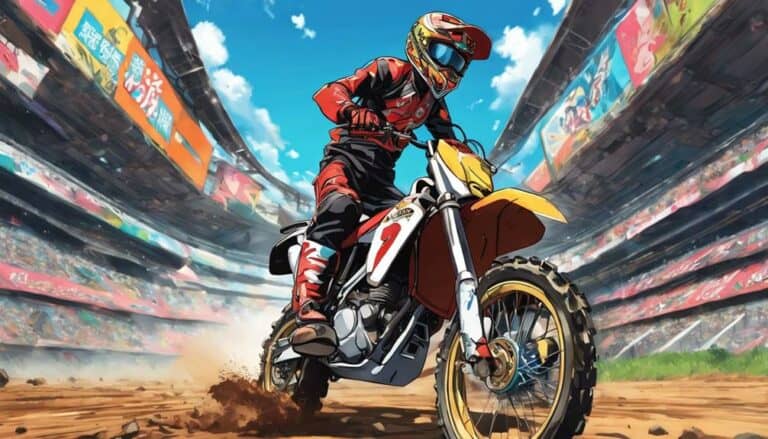You might think executing a brake tap on a dirt bike is a simple task, but mastering this technique involves precision and finesse. The key lies in perfecting the timing and coordination of clutch engagement and brake application to guarantee a smooth and controlled landing.
However, there are additional factors to ponder that can take your brake tapping skills to the next level. Interested in discovering the secrets to enhancing your dirt bike performance through brake tapping?
Key Takeaways
- Use clutch and brake controls for precision in dirt bike maneuvers.
- Locate brake tap lever conveniently on the handlebars.
- Replace old brake tap carefully and inspect for wear.
- Install and adjust the new brake tap for optimal performance.
Tools Needed for Break Tapping
To brake tap a dirt bike effectively, you'll require essential tools like the clutch lever, brake pedal, and rear brake. The front end of the bike is controlled by the clutch lever, which engages and disengages the engine power to the rear wheel. This lever allows you to modulate power delivery as you approach obstacles or corners, giving you precise control over the bike's speed and acceleration.
The brake pedal, on the other hand, is responsible for controlling the rear brake, which helps in slowing down the bike. By applying pressure to the brake pedal, you can regulate the braking force applied to the rear wheel, allowing you to maintain stability while traversing challenging terrain.
Understanding the coordination between the clutch lever, brake pedal, and rear brake is essential for executing smooth and controlled brake taps. Regular practice and familiarity with these tools will enhance your ability to perform precise brake taps on a dirt bike, giving you the confidence to tackle obstacles with ease.
Locating the Brake Tap
Located on the handlebars of your dirt bike, the brake tap is an important control for executing precise maneuvers during your ride. When riding, knowing the exact location of the brake tap is vital for engaging it effectively. Here's how to locate the brake tap:
- On the Handlebars: The brake tap lever is typically located on the right side of the handlebars, within easy reach of your right hand.
- Near the Throttle: It's positioned close to the throttle to enable quick coordination between throttle control and braking.
- Accessible with Your Fingers: You should be able to comfortably reach the brake tap with your fingers without adjusting your grip on the handlebars.
- Next to the Clutch: The brake tap is situated near the clutch lever, allowing for simultaneous operation of both controls when executing complex maneuvers.
Understanding where the brake tap is located on your dirt bike is essential for mastering the technique of brake tapping while riding. Practice finding and using this control to enhance your riding skills and achieve smoother landings.
Removing the Old Brake Tap
When replacing the brake tap on your dirt bike, start by identifying the screws securing the old brake tap in place. Make sure you have the appropriate tools, such as a screwdriver or wrench, to carefully remove these screws without causing damage to the surrounding components.
Once the screws are removed, gently detach the old brake tap from the designated position on the handlebars. Take note of how the old brake tap was positioned and connected to the brake system, as this will help you when installing the new brake tap later on.
Inspect the area where the old brake tap was located for any signs of wear or damage that may need attention before installing the new brake tap.
Installing the New Brake Tap
For precise and efficient brake tapping on your dirt bike, begin by installing the new brake tap with attention to positioning and accessibility for best control. When installing the brake tap, make sure it's tailored to your riding style and braking preferences for top performance during brake tapping maneuvers.
- Choose a rear brake lever with a shorter reach to facilitate quick and precise brake tapping.
- Position the brake lever within easy reach and in a comfortable location that suits your riding style.
- Adjust the rear brake lever to match your hand size and preferred braking technique for enhanced control during brake tapping.
- Utilize high-quality brake components to improve responsiveness and durability when engaging in brake tapping on your dirt bike.
Testing the Brake Tap
To assess the effectiveness of your brake tap technique, conduct rigorous testing under various riding conditions to guarantee consistent performance. When testing the brake tap, start by riding at different speeds and approaching jumps to replicate real-world scenarios.
As you come off the jump, practice pulling in the clutch while hitting the back brake with precise timing. Focus on engaging and releasing the clutch quickly to execute the brake tap smoothly. Make sure the wheel is spinning before landing to stabilize the bike and prevent skidding.
Adjust your body position as the bike's front end drops after the tap to maintain control and stability. Experiment with different jump heights and landing angles to fine-tune your brake tap technique.
Conclusion
To sum up, mastering the brake tap technique on a dirt bike is essential for optimizing performance and safety during jumps.
Did you know that professional motocross riders can brake tap at speeds of up to 60 mph, allowing for precise control and smooth landings?
By practicing drills, focusing on timing, and ensuring proper installation of the brake tap, riders can enhance their skills and overall riding experience.

